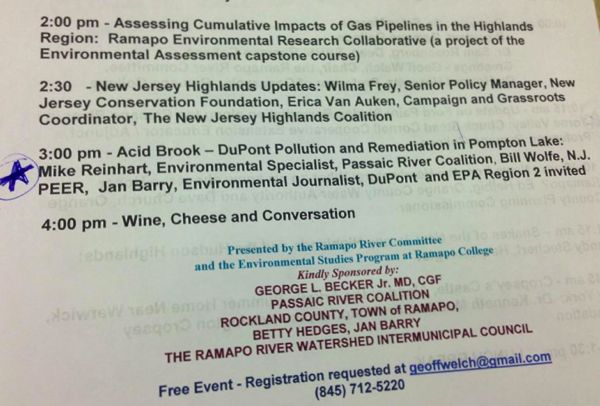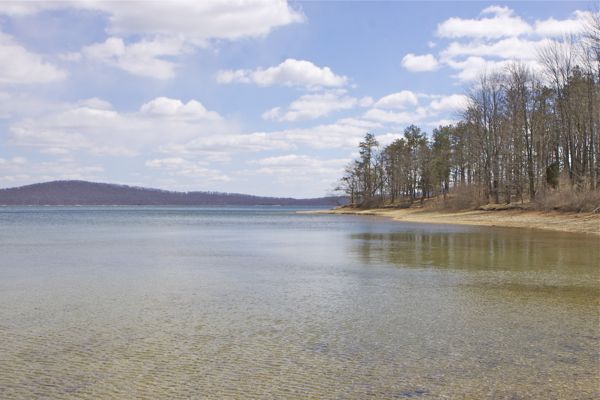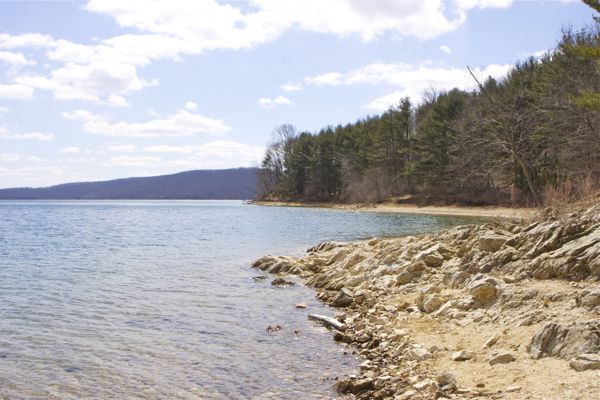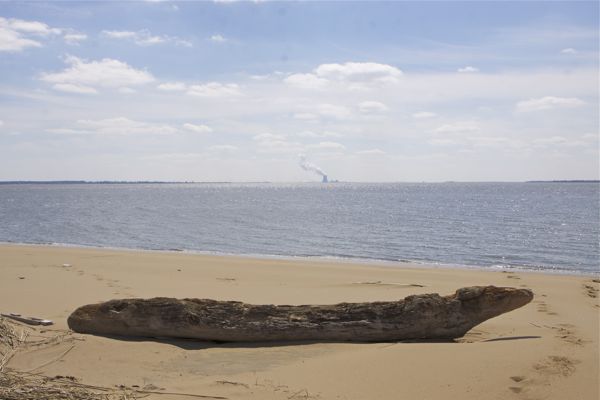Dupont and EPA Abruptly Cancel Appearance at Ramapo College Event
Back out of commitments to participate to avoid critical public debate
[Update: As proof of the EPA lie about why they backed out of this panel discussion, note that EPA spoke in detail about the EAB appeal to a “friendly” audience on April 3, 2013 – see this.]
When I got the invitation to participate in a Ramapo College panel discussion on the Dupont Pompton Lakes toxic nightmare, of course I immediately agreed.
When I was told that my fellow panel members would be Dupont, US EPA, and the Passaic River Coalition (PRC), I knew that panel discussion would never happen – even though Ramapo told me that all had confirmed their participation.
No way would Dupont and EPA agree to publicly face informed and highly critical scrutiny, like this:
- Dupont: Too Big To Jail
- The Great Dupont Train RCRA
- Dupont Pompton Lakes – Still Dirty After All These Years
- Dupont’s Mercury Problem Is Now EPA’s Problem Too
- Documents Show Dupont, EPA, and DEP Knew Of Pompton Lakes Vapor Problem for Seven Years Before Warning Exposed Residents
- DUPONT POMPTON LAKE POLLUTION MAY BE HEADED DOWNSTREAM – DEP Scientists’ Questions Could Prompt Feds to Expand DuPont Cleanup Scope
- FEDERAL WILDLIFE AGENCY FLAYS JERSEY POMPTON LAKES PLAN – Fish & Wildlife Service Conditions Restructure Cleanup and Spur Damage Payments
- US Fish & Wildlife Service Blasts Dupont Science On Mercury Cleanup Plan – Major Rebuke To DEP Review & Challenge to EPA to Strengthen Cleanup
So, despite my reservations, on Friday (April 26), I trucked up to speak at Ramapo College’s 18th annual Watershed Conference:
This year’s conference will present updates on watershed events, including: the Ford paint sludge remediation in Torne Valley in Ramapo, NY; news from the Ramapo River headwaters in Orange County, NY; recent studies on Eastern timber rattlesnakes (a threatened species in New York and New Jersey); Cropsey’s Castle, Aladdin: the artist’s summer home near Warwick, NY – based on new research by Cropsey expert, Dr. Kenneth Maddox, we will get a virtual tour of Cropsey’s design for this legendary mansion, destroyed by fire in 1909 (while he lived at Aladdin, Cropsey frequently traveled to paint in the Ramapo Valley) ; the ongoing pollution from the Mulch Pile Site and the problematic DeMarino Soil Site in Tuxedo, NY; New Jersey Highlands issues; environmental impact assessment of natural gas pipeline expansions in the NJ Highlands Region; DuPont pollution and remediation in Pompton Lakes, NJ.
At last year’s conference, there also was a presentation on the Dupont site:
3:30 – E. Durling Merrill, Environmental Officer Pompton Lakes: 1) The DuPont Acid Brook Cleanup
I wonder if Mr. Merrill disclosed the fact that his salary was paid by Dupont for many years?
This year, in the wake of the controversial EPA issuance of the long awaited final RCRA permit to require Dupont to cleanup a portion of Pompton Lake, the Ramapo agenda included a 1 hour panel discussion of the cleanup – and with a broader set of panelists:
3:00 pm – Acid Brook – DuPont Pollution and Remediation in Pompton Lake: Mike Reinhart, Environmental Specialist, Passaic River Coalition; Jan Barry, Environmental Journalist, Ramapo College Adjunct Professor; Bill Wolfe, N.J. PEER; Ed Merrill, Pompton Lakes Environmental Officer; and a DuPont Representative.
Both Dupont US EPA Region 2 had confirmed their participation. So did the Passaic River Coalition.
But, curiously, just as I expected, they all backed out.
Why were those highly unusual move taken by those 3 groups?
We were told that the lame excuse EPA gave was that it was due to pending litigation. We don’t know what the excuses from Dupont and PRC were. But We assume it was when they saw this:
So, the panel was reduced to myself and Jan Barry, former Record reporter and now an adjunct Ramapo professor.
Jan did a nice job presenting the history of the site, the Record’s excellent coverage, and the cleanup. Jan noted the explosive public reaction to recent disclosures of the vapor intrusion problem, the cancer cluster, and the down-river migration of mercury.
With EPA, Dupont, and PRC no shows, that gave me lots – lots – more time to rip the various failures (see above posts for most of that). I had fun and held nothing back! I’ll see if I can locate a video, I think it was taped.
And, before closing, I need to call bullshit on this From Passaic River Coalition’s 2012 Annual Report:
Pompton Lake Contamination
The PRC submitted comments to EPA about a proposed dredging plan to remove mercury contamination in Pompton Lake. The PRC felt the plan was not extensive enough and would not adequately protect recreational users of the lake or downstream water supply intakes. At the PRC’s suggestion, EPA consulted with the U.S. Fish and Wildlife Services and subsequently modified the dredging permit to treat a larger area of the lake.
In partnership with the citizen group, Pompton Lakes Residents for Environmental Integrity (PLREI), the PRC received a Technical Assistance Grant from the New Jersey Department of Environmental Protection to hire Rich Shoyer of Synergy Environmental, Inc. to review technical data related to the site and present it to the public. The PRC also regularly participates in EPA’s Pompton Lakes Environmental Community Advisory Group.
PRC had no historical involvement in the Dupont cleanup and was installed in Pompton Lakes at the request of the DEP Commissioner. They only parachuted into the conflict to receive promised DEP grant funding.
The purpose was to undercut the advocacy of plume residents and to prevent them and the Edison Wetlands Association from receiving DEP and EPA Technical Assistance Grant (TAG) funding and leading the local advocacy efforts.
It was a very cynical and classic divide and conquer strategy – and it worked. The Pompton Lakes community was further polarized and the involvement of PRC and another group called PLREI splintered the community and made consensus impossible.
PRC did not testify at the EPA public hearing (see the transcript). So, that sure is one hell of a curious way of “reviewing technical data related to the site and presenting it to the public”.
And I know from direct first hand conversations with the professionals involved in the decision that the PRC claim taking credit for the USFWS consultation is false and a flat out lie.
PRC may have submitted written comments to that affect – which I will try to determine – but the Dupont cleanup issues were brought to USFWS attention by myself and that drove EPA’s decision regarding when and how to consult with USFWS as required by the RCRA regulations.
[full disclosure: I receive no funding for my work in Pompton Lakes and have no involvement or expectation of receiving funding under any EPA or DEP TAG grants.]







